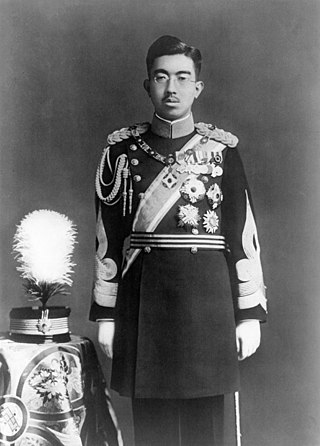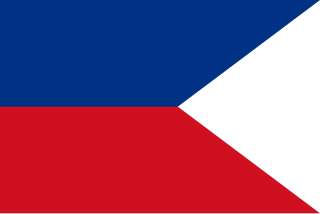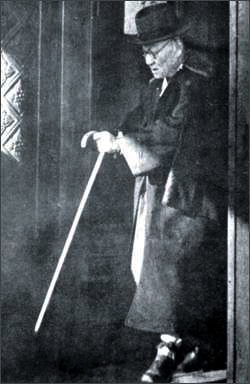
Hirohito, posthumously honored as Emperor Shōwa, was the 124th emperor of Japan according to the traditional order of succession, reigning from 1926 until his death in 1989. He was the longest-reigning Japanese emperor and one of the world's longest-reigning monarchs. As emperor during the Shōwa era, Hirohito oversaw the rise of Japanese militarism, Japan's expansionism in Asia, the outbreak of the Second Sino-Japanese War and World War II, and the postwar Japanese economic miracle.

The Potsdam Declaration, or the Proclamation Defining Terms for Japanese Surrender, was a statement that called for the surrender of all Japanese armed forces during World War II. On July 26, 1945, United States President Harry S. Truman, United Kingdom Prime Minister Winston Churchill, and Chairman of China Chiang Kai-shek issued the document, which outlined the terms of surrender for the Empire of Japan, as agreed upon at the Potsdam Conference. The ultimatum stated that, if Japan did not surrender, it would face "prompt and utter destruction."

Japan was occupied and administered by the Allies of World War II from the surrender of the Empire of Japan on September 2, 1945, at the war's end until the Treaty of San Francisco took effect on April 28, 1952. The occupation, led by the American military with support from the British Commonwealth and under the supervision of the Far Eastern Commission, involved a total of nearly one million Allied soldiers. The occupation was overseen by the US General Douglas MacArthur, who was appointed Supreme Commander for the Allied Powers by the US president Harry S. Truman; MacArthur was succeeded as supreme commander by General Matthew Ridgway in 1951. Unlike in the occupations of Germany and Austria, the Soviet Union had little to no influence in Japan, declining to participate because it did not want to place Soviet troops under MacArthur's direct command.

The Imperial General Headquarters was part of the Supreme War Council and was established in 1893 to coordinate efforts between the Imperial Japanese Army and Imperial Japanese Navy during wartime. In terms of function, it was approximately equivalent to the United States Joint Chiefs of Staff and the British Chiefs of Staff Committee.

The division of Koreade facto began on 2 September 1945, when Japan signed the surrender document, thus ending the Pacific Theater of World War II. It was officially divided with the establishment of the two Koreas in 1948. During World War II, the Allied leaders had already been considering the question of Korea's future following Japan's eventual surrender in the war. The leaders reached an understanding that Korea would be liberated from Japan but would be placed under an international trusteeship until the Koreans would be deemed ready for self-rule. In the last days of the war, the United States proposed dividing the Korean peninsula into two occupation zones with the 38th parallel as the dividing line. The Soviets accepted their proposal and agreed to divide Korea.

The Supreme Commander for the Allied Powers, or SCAP, was the title held by General Douglas MacArthur during the United States-led Allied occupation of Japan following World War II. It issued SCAP Directives to the Japanese government, aiming to suppress its "militaristic nationalism". The position was created at the start of the occupation of Japan on August 14, 1945. It was originally styled the Supreme Commander of the Allied Powers.

General Order No. 1 for the surrender of Japan was prepared by the United States Joint Chiefs of Staff and approved by President Harry Truman on August 17, 1945.
World War II officially ended in Asia on September 2, 1945, with the surrender of Japan on the USS Missouri. Before that, the United States dropped two atomic bombs on Japan, and the Soviet Union declared war on Japan, causing Emperor Hirohito to announce the acceptance of the Potsdam Declaration on August 15, 1945, which would eventually lead to the surrender ceremony on September 2.

The Korean Provisional Government (KPG), formally the Provisional Government of the Republic of Korea, was a Korean government in exile based in China during Japanese rule over Korea.

The People's Republic of Korea was a short-lived provisional government that was organized at the time of the surrender of the Empire of Japan at the end of World War II. It was proclaimed on 6 September 1945, as Korea was being divided into two occupation zones, with the Soviet Union occupying the north and the United States occupying the south. Based on a network of people's committees, it presented a program of democratization of society (민주주의) and the economy (사회주의).
The Korea Democratic Party was the leading opposition party in the first years of the First Republic of Korea. It existed from 1945 to 1949, when it merged with other opposition parties.

The surrender of the Empire of Japan in World War II was announced by Emperor Hirohito on 15 August and formally signed on 2 September 1945, ending the war. By the end of July 1945, the Imperial Japanese Navy (IJN) was incapable of conducting major operations and an Allied invasion of Japan was imminent. Together with the United Kingdom and China, the United States called for the unconditional surrender of Japan in the Potsdam Declaration on 26 July 1945—the alternative being "prompt and utter destruction". While publicly stating their intent to fight on to the bitter end, Japan's leaders were privately making entreaties to the publicly neutral Soviet Union to mediate peace on terms more favorable to the Japanese. While maintaining a sufficient level of diplomatic engagement with the Japanese to give them the impression they might be willing to mediate, the Soviets were covertly preparing to attack Japanese forces in Manchuria and Korea in fulfillment of promises they had secretly made to the US and the UK at the Tehran and Yalta Conferences.

The National Liberation Day of Korea is a public holiday celebrated annually on 15 August in both South Korea and North Korea. It commemorates the day when Korean Peninsula was liberated by the Allies in 1945 from 35 years of Japanese colonial rule. The day also coincides with the anniversary of the founding of South Korea in 1945. Liberation Day is the only political holiday that is celebrated in both North Korea and South Korea.

1945 is an alternate history novel by Michigan economics professor Robert Conroy, an author of alternate history novels, such as 1901 and 1862. It was first published in trade paperback and ebook form by Ballantine Books in May 2007. In the novel's point of divergence, the Kyūjō coup successfully suppresses Japanese Emperor Hirohito's order to surrender and so World War II in the Pacific continues into 1946.

Seoul 1945 is a 2006 South Korean period television series starring Ryu Soo-young, Han Eun-jung, So Yoo-jin, Kim Ho-jin, and Park Sang-myun. It aired on KBS1 from January 1 to September 26, 2006, on Saturdays and Sundays at 21:30 for 71 episodes.

Song Jin-woo was a Korean independence activist, journalist, and politician. His art name was Goha. He was the 3rd, 6th and 8th CEO of the Dong-a Ilbo and the founding leader of the Korea Democratic Party.

Lyuh Woon-hyung, also known by his art name Mongyang, was a Korean independence activist and reunification activist.

The following events occurred in September 1945:
The Left–Right Coalition Movement (Korean: 좌우합작운동) was a movement during the division of Korea led by centrists in 1946. It sought to promote cooperation between the left and right-wing of Korea in establishing a unified, peninsula-wide government after Japanese occupation. To this end, it formed a Left–Right Coalition Committee that brought together Korean politicians from across the political spectrum. It eventually failed in its goal due to increasing political polarization and the loss of the support of the United States, which adopted a firmer anti-communist stance around the beginning of the Cold War.
The following lists events that happened during 1945 in North Korea, then governed by the People's Republic of Korea and Soviet Civil Administration.
















